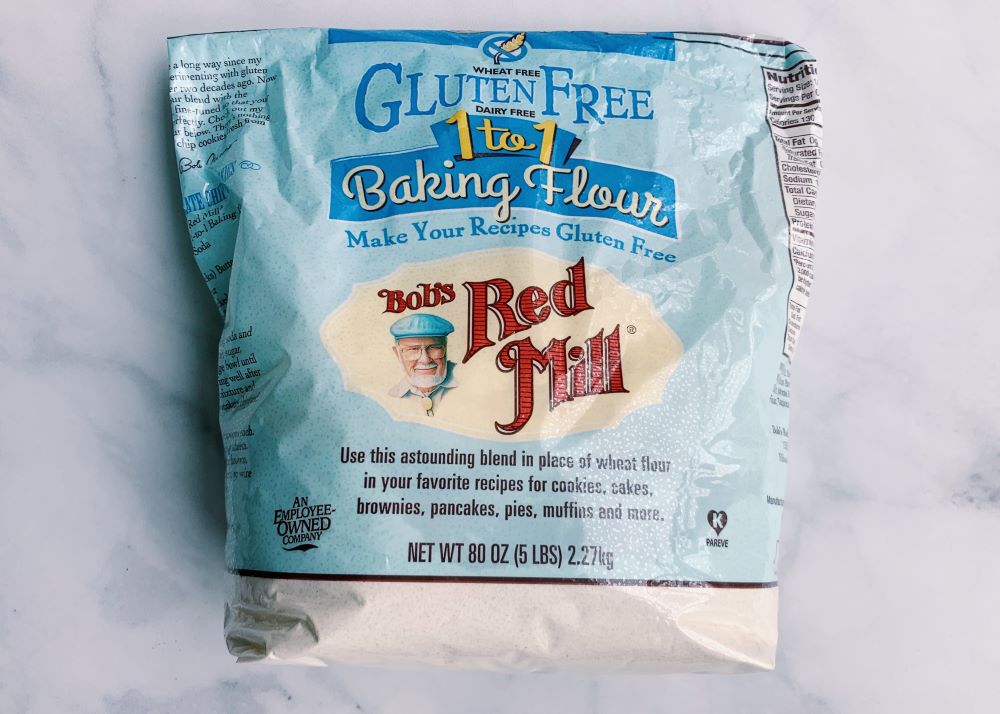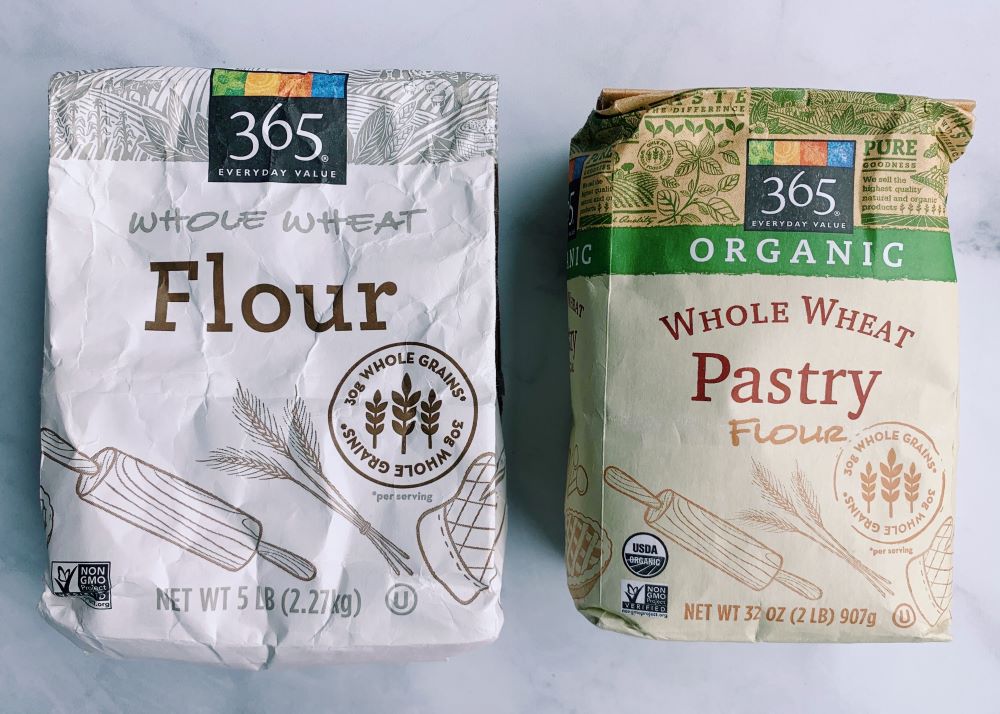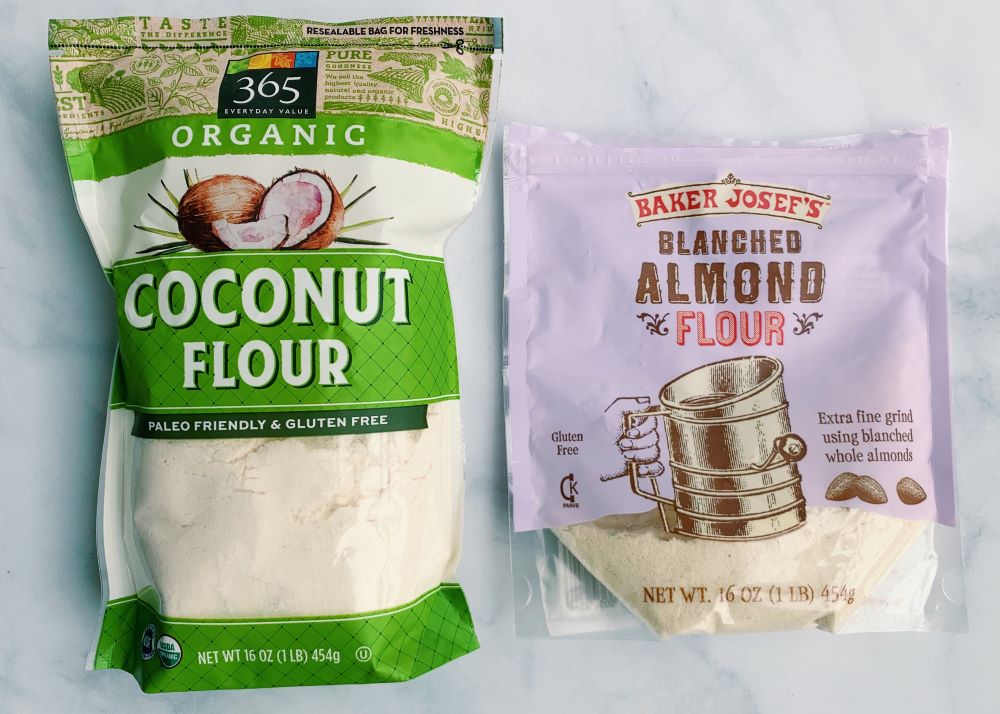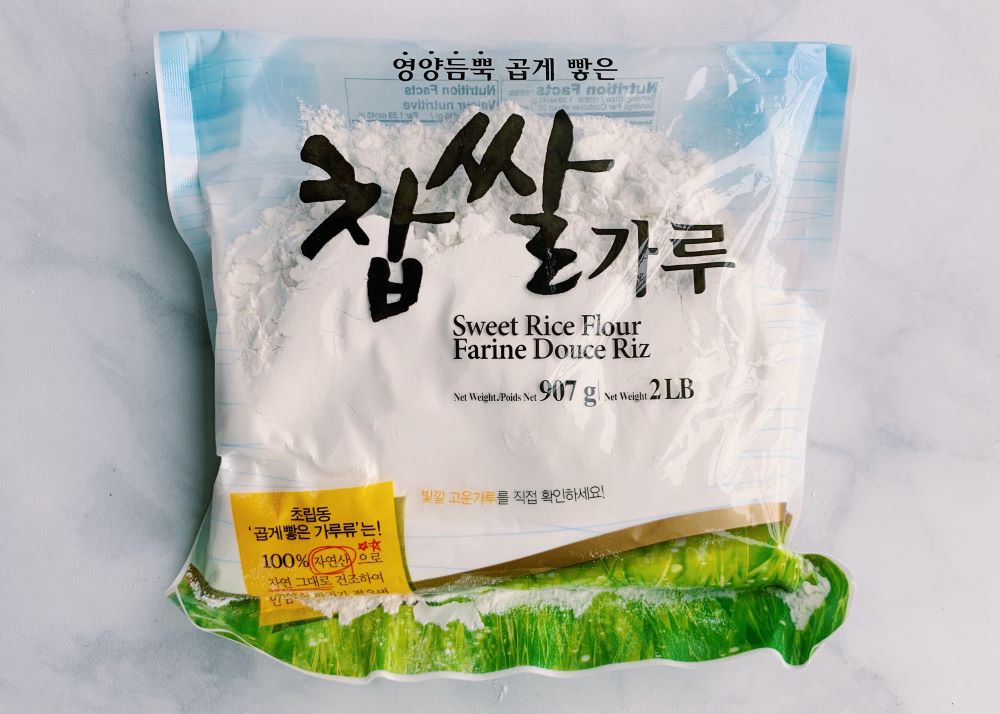Flour Alternatives – A Great Substitution Guide

So Many Choices!
Baking is not easy and can be difficult if you don’t have experience. In addition to the mess of trying to nail down the science of baking, there are also way too many flour alternatives out there for you to use.
I will admit, I am guilty of having so many different types of flour in my pantry, BUT you do not need to go out and buy them all.
I made this guide to explain more about the different types of flour out there and their purpose. That way you can decide what you want to use!
Here are the different flours I’ll be talking about:
- All-Purpose Flour
- Gluten-Free Flour
- Whole Wheat Flour
- Whole Wheat Pastry Flour
- Oat Flour
- Almond Flour
- Coconut Flour
- Sweet Rice Flour
All-Purpose Flour
All-Purpose (white) Flour is the most commonly known and used flour. It is the most affordable flour and the easiest to use to get the best baking results. The reason every recipe doesn’t call for this flour is because it is deemed unhealthy.
The new era has us moving to “flourless” recipes, to healthier Whole Wheat recipes, or to more gluten-friendly recipes. Whatever your reason may be, this is the starting ground when it comes to flour. This flour will be used for comparison to the following “speciality” flours.
Gluten-Free Flour

1 c Gluten-Free Flour = 1 c All-Purpose Flour
Pro: Easiest Gluten-Free alternative to replace All-Purpose Flour
Con: More expensive and processed
If you are looking for an easy gluten-free flour to use in replacement for All-Purpose Flour, then this is the easiest of the gluten-free flour alternatives. This can be found in most grocery stores in the same section that flour is sold. It may also be in a specific “healthy” alternative section.
I prefer the brand Bob’s Red Mill because it is well known and easy to find in all my grocery stores. It will be more expensive than All-Purpose Flour, but the easiest quick fix to make any recipe gluten-free.
Whole Wheat Flours

Whole Wheat Flour
⅓ c Whole Wheat Flour + ⅔ c All-Purpose Flour = 1 c All-Purpose Flour (1:1 Ratio is fine, but will result in a denser texture)
Pro: Affordable, healthy alternative to All-Purpose Flour
Con: Results in a denser texture for baked goods
Regular Whole Wheat Flour is denser than All-Purpose Flour. Therefore, if you substitute All-Purpose Flour 1 for 1 with regular Whole Wheat Flour, then your baked goods will result in having a denser texture. This will not ruin the taste, but only the texture.
Whole Wheat Pastry Flour
1 c Whole Wheat Pastry Flour = 1 c All-Purpose Flour
Pro: Better texture than Whole Wheat Flour
Con: More expensive than Whole Wheat Flour
Whole Wheat Pastry Flour was created to help with providing a more airy texture than if you were to use traditional Whole Wheat Flour. I recommend using this in substitution for All-Purpose Flour.
However, there is a drawback with this. It will cost more to buy Whole Wheat Pastry Flour than traditional Whole Wheat Flour. This flour also is only sold in “health” food stores, for example Whole Foods Market.
Wheat-less Flour Alternatives

Oat Flour
⅓ c Oat Flour + ⅔ c All-Purpose Flour = 1 c All-Purpose Flour (1:1 Ratio is fine, but will result in a denser texture)
Pro: Least processed, gluten-free friendly, healthy alternative to All-Purpose Flour
Con: Results in a denser texture for baked goods
Oat Flour is one of the healthier flour alternatives to both All-Purpose Flour and Whole Wheat Flour. It has more nutrients like fiber and protein. Using Oat Flour in replacement of All-Purpose Flour results in the same issue with using Whole Wheat Flour. The texture of your baked goods will become more dense.
Oat Flour is a great gluten-free flour alternative; however, because there is no gluten you will need yeast if you are baking bread. It is also important to include some sort of binding agent that will act similar to an egg. Here’s where you can find all my suggestions for vegan egg replacements.
Oat Flour can be purchased in most grocery stores; however, I recommend making it yourself. If you have a blender or food processor, then you can simply blend up some oats to make Oat Flour. If you don’t mind some oat clumps, then you can use the flour right out of the blender. If you don’t want oat clumps, then you can sift them out. I like to make this in bulk and store for later.
Coconut Flour
¼ c Coconut Flour = 1 c All-Purpose Flour
Pros: Perfect for anyone with any allergies (gluten, nuts, etc.)
Cons: Very absorbent and tends to dry out baked goods
Similar to Oat Flour, Coconut Flour is a healthier and gluten-free alternative to both All-Purpose Flour and Whole Wheat Flour. Coconut Flour is extremely absorbent and will require more wet ingredients than a traditional recipe may require.
Coconut Flour is a great gluten-free flour alternative; however, because there is no gluten you will need yeast if you are baking bread. It is also important to include some sort of binding agent that will act similar to an egg. Here’s where you can find all my suggestions for vegan egg replacements.
I recommend pairing this flour with another flour for better taste and texture because Coconut Flour tends to produce a more dry and gritty texture if used by itself.
Almond Flour
2 c Almond Flour = 1 c All-Purpose Flour
Pros: Gluten-free friendly, healthy alternative to All-Purpose Flour
Cons: More expensive gluten-free option and creates a nut allergy concern
Similar to Oat Flour, Almond Flour is one of the healthier flour alternatives to both All-Purpose Flour and Whole Wheat Flour. However, if you have a nut allergy then this poses another issue. Almond flour will also cost more because almonds are more expensive than oats.
Almond Flour works opposite in comparison to Coconut Flour. It releases more moisture and requires more flour in comparison to All-Purpose Flour. This is why it is great to use a combination of Almond Flour and Coconut Flour to oppose one another’s weaknesses.
Almond Flour is a great gluten-free flour alternative; however, because there is no gluten you will need yeast if you are baking bread. It is also important to include some sort of binding agent that will act similar to an egg. Here’s where you can find all my suggestions for vegan egg replacements.
Asian Specialty Flours

Sweet Rice Flour
I don’t use this flour in replacement for All-Purpose Flour, but this is the flour that I use to make my Mochi recipe.
Traditionally, mochi is made by pounding white rice until it becomes sticky and chewy. This is a long process and therefore I just buy Sweet Rice Flour to use if I want to make any mochi.
This can be found in international grocery stores and is very affordable.
THANKS FOR READING
Thank you Nutti’s for taking the time to read this post and I truly hope you enjoy this guide to Flour Alternatives! If you used any of these flours in a recipe, please let me know it went in the comments below!
Feel free to pin this article to Pinterest if you liked it! I always love to see what recipes you enjoy. Also, you can follow me on Pinterest for more recipes and articles, just click the link below my bio or search for Nutti Nelli!
Mahalo!
Janelle

